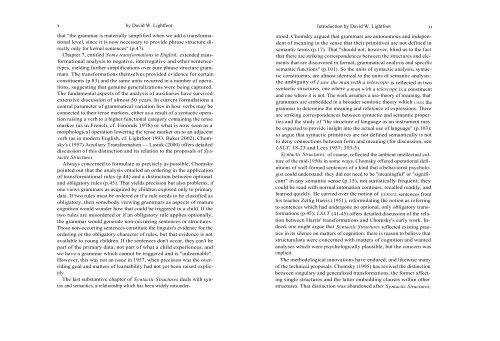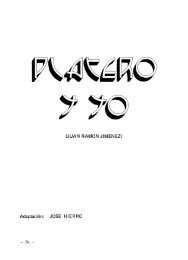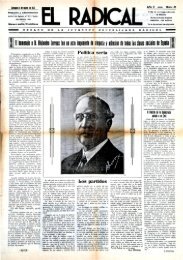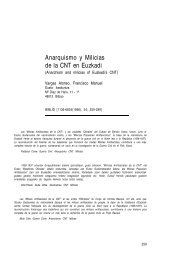Syntactic-Structure,Chomsky
Syntactic-Structure,Chomsky
Syntactic-Structure,Chomsky
You also want an ePaper? Increase the reach of your titles
YUMPU automatically turns print PDFs into web optimized ePapers that Google loves.
x by David W. Lightfoot Introduction by David W. Lightfoot xi<br />
that "the grammar is materially simplified when we add a transformational<br />
level, since it is now necessary to provide phrase structure directly<br />
only for kernel sentences" (p.47).<br />
Chapter 7, entitled Some transformations in English, extended transformational<br />
analysis to negative, interrogative and other sentencetypes,<br />
yielding further simplifications over pure phrase structure grammars.<br />
The transformations themselves provided evidence for certain<br />
constituents (p.83) and the same units recurred in a number of operations,<br />
suggesting that genuine generalizations were being captured.<br />
The fundamental aspects of the analysis of auxiliaries have survived<br />
extensive discussion of almost 50 years. In current formulations a<br />
central parameter of grammatical variation lies in how verbs may be<br />
connected to their tense markers, either as a result of a syntactic operation<br />
raising a verb to a higher functional category containing the tense<br />
marker (as in French, cf. Emonds 1978) or what is now seen as a<br />
morphological operation lowering the tense marker on to an adjacent<br />
verb (as in modern English, cf. Lightfoot 1993, Baker 2002), <strong>Chomsky</strong>'s<br />
(1957) Auxiliary Transformation — Lasnik (2000) offers detailed<br />
discussion of this distinction and its relation to the proposals of <strong>Syntactic</strong><br />
<strong>Structure</strong>s.<br />
Always concerned to formulate as precisely as possible, <strong>Chomsky</strong><br />
pointed out that the analysis entailed an ordering in the application<br />
of transformational rules (p.44) and a distinction between optional<br />
and obligatory rules (p.45). That yields precision but also problems, if<br />
one views grammars as acquired by children exposed only to primary<br />
data. If two rules must be ordered or if a rule needs to be classified as<br />
obligatory, then somebody viewing grammars as aspects of mature<br />
cognition would wonder how that could be triggered in a child. If the<br />
two rules are misordered or if an obligatory rule applies optionally,<br />
the grammar would generate non-occurring sentences or structures.<br />
Those non-occurring sentences constitute the linguist's evidence for the<br />
ordering or the obligatory character of rules, but that evidence is not<br />
available to young children. If the sentences don't occur, they can't be<br />
part of the primary data, not part of what a child experiences, and<br />
we have a grammar which cannot be triggered and is "unlearnable".<br />
However, this was not an issue in 1957, when precision was the overriding<br />
goal and matters of learnability had not yet been raised explicitly.<br />
The last substantive chapter of <strong>Syntactic</strong> <strong>Structure</strong>s deals with syntax<br />
and semantics, a relationship which has been widely misunderstood.<br />
<strong>Chomsky</strong> argued that grammars are autonomous and independent<br />
of meaning in the sense that their primitives are not defined in<br />
semantic terms (p.17). That "should not, however, blind us to the fact<br />
that there are striking correspondences between the structures and elements<br />
that are discovered in formal, grammatical analysis and specific<br />
semantic functions" (p.101). So the units of syntactic analysis, syntactic<br />
constituents, are almost identical to the units of semantic analysis:<br />
the ambiguity of I saw the man with a telescope is reflected in two<br />
syntactic structures, one where a man with a telescope is a constituent<br />
and one where it is not. The work assumes a use-theory of meaning, that<br />
grammars are embedded in a broader semiotic theory which USES the<br />
grammar to determine the meaning and reference of expressions. There<br />
are striking correspondences between syntactic and semantic properties<br />
and the study of "the structure of language as an instrument may<br />
be expected to provide insight into the actual use of language" (p.103);<br />
to argue that syntactic primitives are not defined semantically is not<br />
to deny connections between form and meaning (for discussion, see<br />
LSLT, 18-23 and Lees 1957: 393-5).<br />
<strong>Syntactic</strong> <strong>Structure</strong>s, of course, reflected the ambient intellectual culture<br />
of the mid-1950s in some ways. <strong>Chomsky</strong> offered operational definitions<br />
of well-formed sentences of a kind that a behaviorist psychologist<br />
could understand: they did not need to be "meaningful" or "significant"<br />
in any semantic sense (p.15), not statistically frequent; they<br />
could be read with normal intonation contours, recalled readily, and<br />
learned quickly. He carried over the notion of KERNEL sentences from<br />
his teacher Zellig Harris (1951), reformulating the notion as referring<br />
to sentences which had undergone no optional, only obligatory transformations<br />
(p.45); LSLT (41-45) offers detailed discussion of the relation<br />
between Harris' transformations and <strong>Chomsky</strong>'s early work. Indeed,<br />
one might argue that <strong>Syntactic</strong> <strong>Structure</strong>s reflected existing practice<br />
in its silence on matters of cognition: there is reason to believe that<br />
structuralists were concerned with matters of cognition and wanted<br />
analyses which were psychologically plausible, but the concern was<br />
implicit.<br />
The methodological innovations have endured, and likewise many<br />
of the technical proposals. <strong>Chomsky</strong> (1995) has revived the distinction<br />
between singulary and generalized transformations, the former affecting<br />
single structures and the latter embedding clauses within other<br />
structures. That distinction was abandoned after <strong>Syntactic</strong> <strong>Structure</strong>s,






